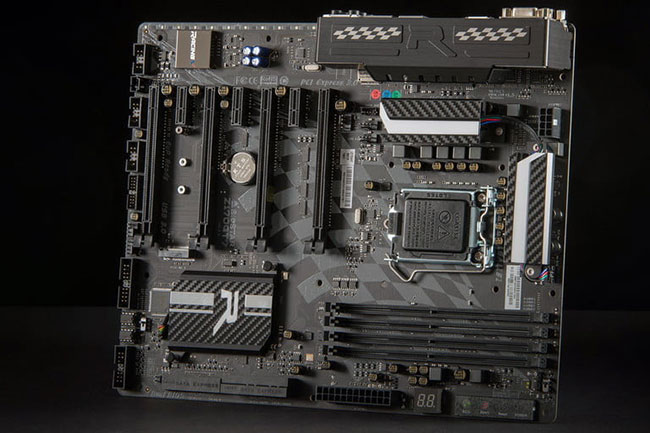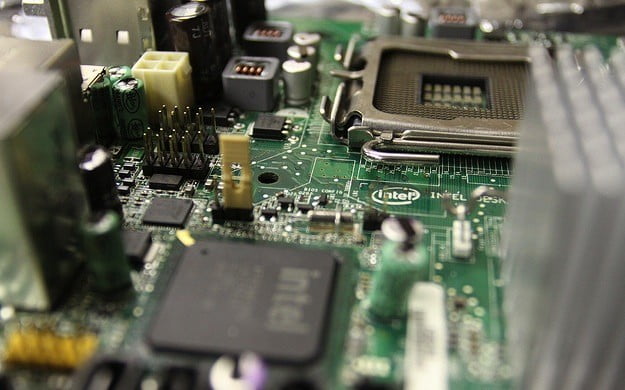What is motherboard? What is a motherboard?
But what is a motherboard? And more importantly, what task does it perform?
If you think of the computer as a body, the motherboard would be the circulatory system. The motherboard is responsible for power routing, which helps coordinate how all the components work together.
Note that the mainboard is not the same as the CPU, where all the calculations are performed. The motherboard simply organizes these calculations and their results. Despite keeping such a simple task, nothing else can work without the motherboard, which is why the mainboard is considered very important. Here's what you need to know about this department.
What is a motherboard? What is its function?
 What is motherboard? What is a motherboard? Picture 1
What is motherboard? What is a motherboard? Picture 1
The main purpose of the motherboard is to transmit power and provide a central location where all components can communicate with each other. Your motherboard alone does not affect performance at all. However, depending on the chipset (more on chipsets to come), your motherboard may enable higher performance when paired with other hardware.
Another important function of the motherboard is to load the operating system. An on-board firmware chip stores the Basic Input/Output System (BIOS). This very lightweight application is the first thing your computer loads, allowing it to read data from the hard drive and, finally, load the operating system. As the name suggests, BIOS is 'basic'. The problem is making all the components recognize each other before loading the operating system.
The functionality of the motherboard is largely determined by the chipset. The motherboard's chipsets are responsible for handling communication between your various components, and they come from CPU manufacturers (AMD and Intel both have multiple chipset options). You will often see CPU manufacturers release new chipsets along with new generations of processors. That's because the chipset is where most motherboard innovations happen, allowing users to use more RAM and access features like PCIe 4.0, among other things.
Motherboards also handle the hurdles of building a computer. The motherboard layout is intentional, important power transmission and communication components must be located close to the components that need them. For example, your CPU receives power through the motherboard. However, the motherboard also has a voltage regulation module (VRM) placed between the power connection and the processor to maintain consistent power.
Where is the motherboard located?
The motherboard is located inside the computer case, where most of the computer's components and peripherals are connected. With desktop computers, the motherboard is located on the left or right side of the case and is the largest circuit board.
What components make up a motherboard?
 What is motherboard? What is a motherboard? Picture 2
What is motherboard? What is a motherboard? Picture 2
There are a number of different motherboard designs and styles, which have been updated over the years for different devices and by ever-evolving technology. However, all motherboards have a few things in common. They all have circuits used to coordinate computer processes and heat sinks to absorb and redirect heat to help the motherboard stay cool during use. Most have a secondary power source.
The first thing you will notice when looking at any motherboard is that it has a lot of slots and connections. Since everything is routed through the motherboard, it needs physical contact with nearly all computer components, including the main power, CPU, RAM slots, USB, PCI, video and sound cards, as well as expansion slots.
If you use a wireless mouse or external keyboard, they have connections along with any other essential accessories you might want. This utility is why the motherboard appears to be a circle - that's its main function.
Over time, ports on motherboards tend to change based on the needs of current technology. This is why an older motherboard may have many defunct ports for outdated connections.
In most cases, those are peripheral ports. The motherboard handles internal connections like RAM and CPU, and also handles external connections like USB and Thunderbolt. Additionally, the motherboard provides networking ports (via Ethernet, WiFi, or both) and often provides a video connection (if your processor has an integrated graphics card on the board).
Connections have changed and adapted over time, but the purpose of the motherboard remains the same: It is a central component of the PC. Everything that connects to a computer must connect to the motherboard in one way or another. Even the USB ports on the front of the computer case connect directly to the motherboard.
What are the functions of the motherboard?
The motherboard plays several important functions in a computer system.
First and foremost, the motherboard serves as the central platform that allows different components to connect and communicate with each other.
The second important function of the motherboard is to provide power to the various components connected to it. The motherboard distributes power from the PSU to various components, as well as a voltage regulator to ensure those components don't become overloaded or experience power surges that could damage them.
The motherboard also facilitates data transfer between different components by using special circuits called buses and interfaces that allow data to pass between the CPU, RAM, storage devices, and open cards. wide and other peripheral devices. These interfaces can include SATA, USB, PCIe, Ethernet, and audio interfaces, among others.
The BIOS or UEFI chip on the motherboard contains the necessary firmware to provide instructions and settings to initialize the computer's hardware during system startup. It performs tasks such as Power-On Self-Test (POST), which tests the system's hardware and provides a basic set of instructions to boot the operating system.
Finally, the motherboard generates a clock signal that synchronizes the operations of the various components so that everything operates in order, much like traffic lights help traffic flow smoothly. The clock signal ensures that transmission, processing, and other operations occur at the right time, prevents data errors, and enables coordination between components to prevent cascading bottlenecks that can cause a machine to fail. 'freezing'.
Overall, the motherboard serves as the foundation of a computer system, supporting communication, power distribution, data transfer, and coordination between all components, ultimately allowing the system to function.
What is the difference between CPU and motherboard?
CPU and motherboard are two separate components in a computer system and have different functions.
The CPU is often called the "brain" of the computer. The CPU is responsible for executing commands, calculations, and controlling the overall operation of the system. The CPU is the microprocessor that handles the majority of computational tasks in a computer. The CPU consists of an arithmetic logic unit (ALU), a controller, and a cache memory.
The motherboard contains several major components such as CPU sockets, RAM slots, expansion slots, storage connectors, power connectors, and I/O ports but does not execute any commands. It is simply a bridge by which PC components can communicate and collaborate with each other securely and efficiently.
Is a motherboard needed in a PC?
The answer is yes, the motherboard is an essential component in a PC, just like the skeleton necessary for the human body to function.
Without a motherboard, every component of the computer would need to have independent connections to other components it might need to perform a given task, and without a motherboard, the components would This part will also be subject to dangerous voltage fluctuations that can damage the circuitry within them.
You should read it
- Mainboard, Motherboard is what? Overview of Mainboard on computer
- Things to know when choosing to buy mainboard
- How to assemble the CPU into the mainboard of the computer
- Choosing a motherboard for a computer
- How to assemble the Mainboard into the computer case
- 6 best gaming motherboards in 2019
- Instructions on how to assemble the CPU into the standard LGA775 . mainboard
- How to assemble memory into the mainboard of a computer
- Instructions for checking the mainboard model and motherboard manufacturer
- Top 5 best 2021 B550 motherboards
- How to use CPU heatsink
- What is motherboard? Learn about the mainboard in the computer
May be interested

Sound Booster error and how to fix it when using it

Instructions to fix double click error on computer mouse - Click once becomes twice

Top 10 best tablets 2024

8 best SSD hard drives for Windows computers 2024

Fix printer errors with blurred text and blurred lines

How to fix common mouse errors on laptops






 Instructions for checking the mainboard model and motherboard manufacturer
Instructions for checking the mainboard model and motherboard manufacturer The terms you need to know when buying a motherboard
The terms you need to know when buying a motherboard Things to know when choosing to buy mainboard
Things to know when choosing to buy mainboard Leaked images of upcoming Lenovo gaming motherboards
Leaked images of upcoming Lenovo gaming motherboards What is motherboard? Learn about the mainboard in the computer
What is motherboard? Learn about the mainboard in the computer 5 best B760 motherboards in 2024
5 best B760 motherboards in 2024